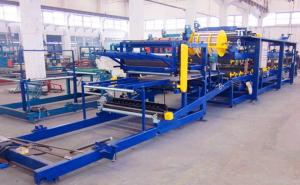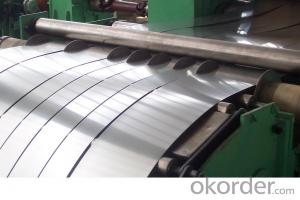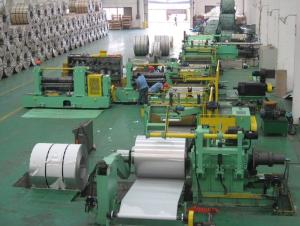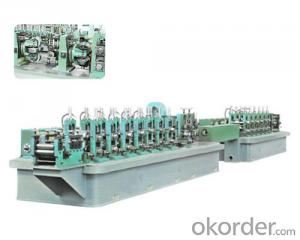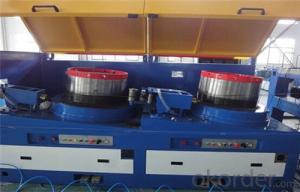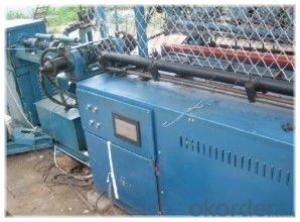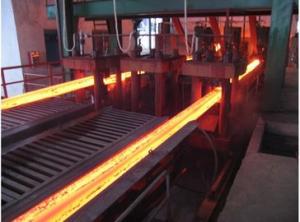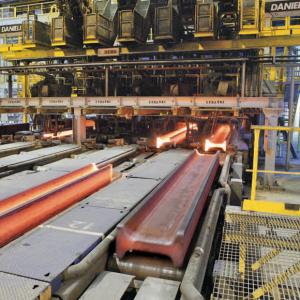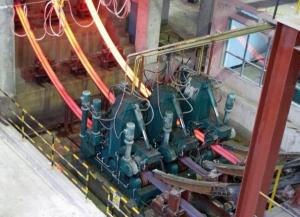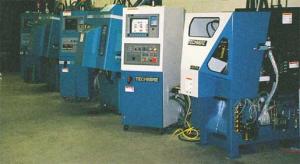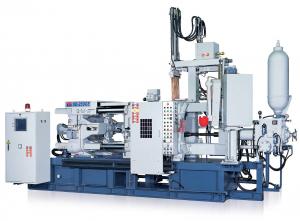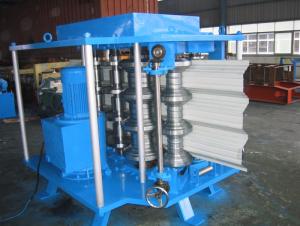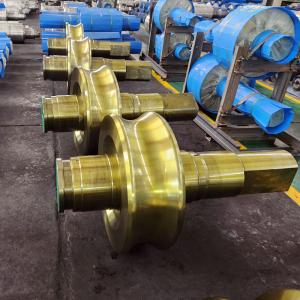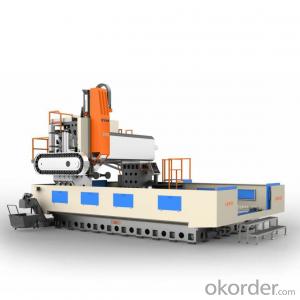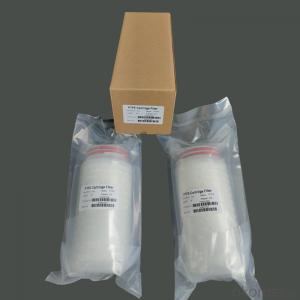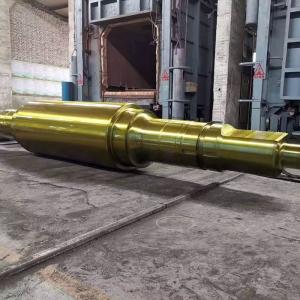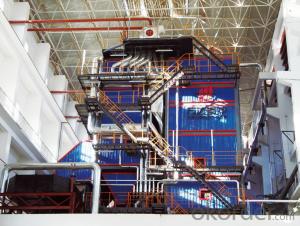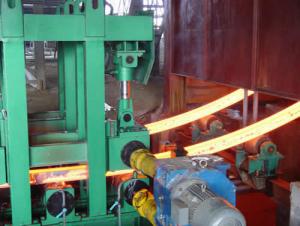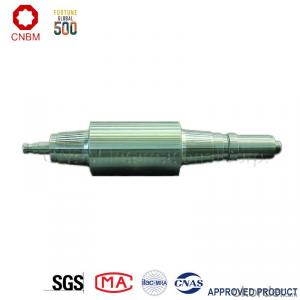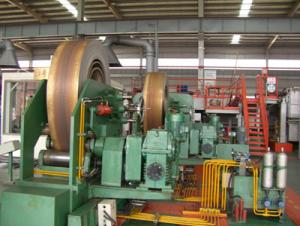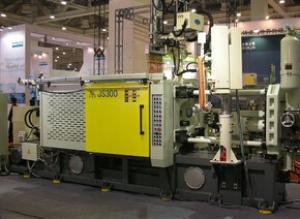Continuous Casting Machine for Steel
- Loading Port:
- China Main Port
- Payment Terms:
- TT or LC
- Min Order Qty:
- 1 Set set
- Supply Capability:
- 30 Sets Per Year set/month
OKorder Service Pledge
Quality Product, Order Online Tracking, Timely Delivery
OKorder Financial Service
Credit Rating, Credit Services, Credit Purchasing
You Might Also Like
Technology process:
1.Heat the EVA film
2.Cover the heated EVA film on the mould(can be made from wood or aluminum)
3.Spray a coating in a certain baume degree
4.Put on the empty blask
5.Sand-up the flask and vibrate to compaction
Packaging & Delivery
Packaging Details:containers
Delivery Detail:a set complete equipment needed producting three months
- Q:What safety precautions should be taken when operating metal casting machinery?
- When operating metal casting machinery, several safety precautions should be taken to ensure the well-being of the operator and those in the surrounding area. These precautions include wearing appropriate personal protective equipment (PPE) such as safety glasses, gloves, and protective clothing to prevent injuries from flying debris, high temperatures, or chemical splashes. Additionally, operators should receive proper training on the safe operation of the machinery, understand the potential hazards associated with the equipment, and follow all safety guidelines provided by the manufacturer. Regular inspections and maintenance of the machinery are also crucial to identify any potential hazards or malfunctions that could compromise safety. Finally, having clear and visible warning signs, adequate lighting, and implementing proper housekeeping practices in the work area can further reduce the risk of accidents and injuries when operating metal casting machinery.
- Q:How is the dimensional accuracy of the final product ensured in metal casting machinery?
- The dimensional accuracy of the final product in metal casting machinery is ensured through several key processes and techniques. Firstly, the design and engineering of the casting mold play a crucial role in achieving dimensional accuracy. The mold is designed with precision and attention to detail, taking into account factors such as shrinkage, allowances, and tolerances. Computer-aided design (CAD) and computer-aided manufacturing (CAM) technologies are often used to create highly accurate and precise molds. Next, the selection of appropriate materials and their properties are essential in maintaining dimensional accuracy. The metal alloys used in casting must exhibit minimal shrinkage and distortion during solidification. This is achieved by carefully choosing alloys with low thermal expansion and good fluidity. During the casting process, proper control of the temperature and cooling rate is crucial. The molten metal is poured into the mold at the correct temperature and under controlled conditions to prevent rapid cooling or overheating, which can lead to dimensional inaccuracies. Additionally, the use of chillers or cooling systems helps regulate the cooling rate and ensures uniform solidification, minimizing the risk of distortions. Regular monitoring and inspection of the casting machinery and process are also essential for maintaining dimensional accuracy. Advanced technologies like laser scanning and coordinate measuring machines (CMM) are used to measure and verify the dimensions of the cast parts. Any deviations from the desired specifications can be quickly identified and corrective actions taken. Furthermore, post-processing techniques such as machining, grinding, and polishing are employed to refine the dimensions and achieve the desired tolerances. These processes remove any excess material or surface imperfections, ensuring the final product meets the required dimensional accuracy. In summary, the dimensional accuracy of the final product in metal casting machinery is ensured through meticulous mold design, careful selection of materials, precise control of temperature and cooling, regular monitoring and inspection, and post-processing techniques. By implementing these measures, manufacturers can produce high-quality castings that meet the specified dimensional requirements.
- Q:What are the post-processing steps involved in metal casting machinery?
- The metal casting machinery's post-processing steps vary depending on specific requirements and the desired final product. However, there are generally several common post-processing steps involved. 1. Eliminating the gating system: Once the metal casting has solidified, the gating system, which consists of the sprue, runners, and gates, must be removed. This can be accomplished by cutting, grinding, or sawing. 2. Cleaning and deburring: Metal castings often have surplus material or rough edges, commonly referred to as burrs. These must be eliminated through techniques such as grinding, filing, or sanding. This step guarantees that the final product possesses smooth surfaces and precise dimensions. 3. Heat treatment: Some metal castings necessitate heat treatment to enhance their mechanical properties. Heat treatment procedures may involve annealing, tempering, quenching, or normalizing, depending on the desired outcome. 4. Machining: To achieve accurate dimensions and smooth surfaces, metal castings may undergo machining procedures. This may entail milling, drilling, turning, or grinding to eliminate excess material and shape the casting to its final form. 5. Surface finishing: Depending on the application and aesthetic requirements, metal castings may undergo surface finishing procedures. This can encompass polishing, buffing, sandblasting, or coating to enhance the appearance and protect the casting from corrosion. 6. Quality inspection: Once the post-processing steps have been completed, metal castings undergo comprehensive quality inspections. This encompasses visual inspection, dimensional checks, and non-destructive testing methods such as X-ray or ultrasound to ensure that the casting meets the necessary standards. 7. Final assembly: In certain instances, additional components or parts may need to be assembled with the metal castings to create the final product. This may involve welding, fastening, or bonding the castings together. In summary, the post-processing steps in metal casting machinery aim to eliminate excess material, refine the casting's shape and dimensions, enhance its mechanical properties, improve its surface finish, and ensure its quality and functionality for the intended application.
- Q:How is the casting inspected for microstructure in metal casting machinery?
- Various techniques are employed in metal casting machinery to inspect the microstructure of the casting and guarantee the quality and integrity of the end product. Metallography is a commonly utilized method, which necessitates extracting a small sample from the casting and preparing it for microscopic examination. Initially, the sample is mounted in a resin or metallographic mounting medium and subsequently ground and polished to achieve a smooth surface, facilitating better visualization of the microstructure. Then, a chemical solution is applied to the sample to etch it and enhance the clarity of the microstructural features. Afterward, the prepared sample is placed beneath a metallurgical microscope, enabling observation at different magnifications. This permits examination of the grain structure, identification of defects such as shrinkage or porosity, and assessment of the distribution of phases or constituents within the metal. X-ray radiography is another technique employed to inspect the microstructure. This method involves exposing the casting to X-rays and capturing the resulting image on a radiographic film or digital detector. By analyzing the X-ray image, internal defects like cracks, voids, or inclusions that may not be visible on the surface can be identified. Ultrasonic testing is also frequently utilized for metal casting inspection. It entails transmitting high-frequency sound waves through the casting, which are then reflected back by internal defects. The resulting echoes are analyzed to determine the presence and location of any abnormalities. Finally, non-destructive testing techniques like dye penetrant inspection and magnetic particle inspection can be employed to detect surface cracks, discontinuities, or defects on the casting. In conclusion, inspecting the microstructure in metal casting machinery involves a combination of different techniques to ensure the quality and reliability of the final product. These methods are crucial in detecting any defects or irregularities that could compromise the structural integrity and performance of the casting.
- Q:How are the molds prepared for sand casting in metal casting machinery?
- In metal casting machinery, molds are prepared for sand casting by first creating a pattern of the desired product. This pattern is typically made of wood, plastic, or metal and represents the final shape of the casting. The pattern is then placed in a flask, which is a box-like container that holds the sand. The flask is filled with specially formulated sand, known as molding sand, which is highly compactable and can retain its shape. The sand is then packed tightly around the pattern, ensuring that all the intricate details are captured. Once the sand has been packed, the pattern is removed, leaving behind a cavity in the shape of the desired product. This cavity is then ready to be filled with molten metal, creating the final casting.
- Q:How does metal casting machinery handle the documentation and traceability of castings?
- The documentation and traceability of castings in metal casting machinery are managed through various processes and technologies. An essential aspect of this is the use of distinct identification codes or labels for each casting. These codes are typically applied directly onto the castings using techniques like laser engraving, stamping, or tagging. When a casting is made, it is given a unique identification code that contains important information such as the production date, batch number, type of metal, and other specific details needed for traceability. This code is then recorded in a database or electronic system, connecting it to the associated manufacturing data. Metal casting machinery also employs advanced software systems to acquire and monitor real-time data. These systems automatically record crucial parameters during the casting process, like temperature, pressure, and time, ensuring accurate data collection. The data is stored in a centralized database, which can be accessed for documentation and traceability purposes. In addition to documenting and recording data, metal casting machinery may incorporate quality control measures such as non-destructive testing techniques. These techniques, including X-ray, ultrasonic, or magnetic particle testing, are used to inspect castings for defects or irregularities. The test results are then documented and stored alongside the relevant casting information, creating a comprehensive record of each casting's quality and integrity. Moreover, metal casting machinery may integrate barcode or RFID technology to streamline the tracking and tracing of castings throughout the production and supply chain. These technologies enable quick and accurate identification of castings, making it easier to retrieve relevant documentation and traceability information. Overall, metal casting machinery utilizes a combination of unique identification codes, advanced software systems, quality control measures, and tracking technologies to handle the documentation and traceability of castings. These processes ensure that all necessary information is recorded, stored, and easily accessible, facilitating efficient quality control, production management, and traceability throughout each casting's lifecycle.
- Q:What is the maintenance required for metal casting machinery?
- The maintenance required for metal casting machinery primarily involves regular inspections, cleaning, lubrication, and addressing any issues or repairs that may arise. Firstly, it is important to conduct regular inspections of the machinery to identify any signs of wear and tear, such as cracks, rust, or loose parts. These inspections should be done on a routine basis to ensure that the machinery is functioning properly and to prevent any potential breakdowns or accidents. Cleaning is another crucial aspect of maintenance for metal casting machinery. Dust, debris, and metal shavings can accumulate inside the machinery, which can hinder its performance and lead to premature wear. Regular cleaning of the machinery, both internally and externally, using appropriate cleaning agents and tools, is necessary to keep it in optimal condition. Proper lubrication is also essential for the smooth operation of the metal casting machinery. Moving parts, such as gears, bearings, and slides, should be lubricated regularly to reduce friction and wear. It is important to use the correct type and amount of lubricant specified by the manufacturer to ensure effective lubrication without causing any damage to the machinery. In addition to regular inspections, cleaning, and lubrication, any issues or malfunctions that may arise should be promptly addressed. This may involve replacing worn-out parts, repairing damaged components, or adjusting settings to maintain the machinery's performance. It is advisable to have a qualified technician or engineer carry out such repairs or adjustments to ensure proper functioning and safety. Overall, the maintenance required for metal casting machinery involves a combination of routine inspections, cleaning, lubrication, and timely repairs. Following a comprehensive maintenance schedule and adhering to the manufacturer's guidelines can help prolong the lifespan of the machinery, minimize downtime, and ensure safe and efficient metal casting operations.
- Q:What are the ergonomic considerations for operating metal casting machinery?
- When it comes to the operation of metal casting machinery, it is crucial to consider several important ergonomic factors. These considerations are essential for the safety, comfort, and overall well-being of the operators. First and foremost, the machinery itself should be designed with ergonomics in mind. This means that the controls, buttons, and switches should be easily accessible and at the right height. Operators should not have to strain or stretch their bodies to reach these controls, as it can lead to musculoskeletal disorders and injuries over time. Additionally, the layout of the machinery should allow operators to move freely without any obstacles or hazards in their way. Another important consideration is the weight and handling of the materials used in the metal casting process. Operators may need to lift, carry, or manipulate heavy metal components, which can strain their bodies if not done correctly. It is crucial to provide appropriate lifting aids, such as cranes or hoists, to minimize the risk of back injuries or strains. Furthermore, the machinery should be designed to reduce excessive noise and vibrations. Prolonged exposure to high noise levels can cause hearing loss, while excessive vibrations can lead to discomfort, fatigue, and long-term damage to the musculoskeletal system. Implementing noise reduction measures, like soundproof enclosures or ear protection, and using materials that dampen vibrations can help mitigate these risks. Proper lighting is also a crucial consideration. Adequate lighting is necessary for operators to accurately see and inspect the metal components. Insufficient or poorly positioned lighting can strain the eyes, reduce visibility, and increase the risk of errors or accidents. Therefore, it is important to provide appropriate lighting conditions, such as adjustable and directed task lighting, to ensure optimal visibility and reduce eye fatigue. Lastly, training and education are vital in promoting ergonomic practices among operators. They should receive training on proper lifting and handling techniques and be educated about the potential risks and hazards associated with their work. Encouraging regular breaks and job rotation can also help prevent prolonged exposure to repetitive tasks and reduce the risk of fatigue or overexertion. In conclusion, operating metal casting machinery requires careful attention to ergonomic considerations to ensure the safety, comfort, and well-being of the operators. By optimizing the machinery design, providing adequate lifting aids, minimizing noise and vibrations, ensuring proper lighting conditions, and offering comprehensive training, operators can perform their tasks more efficiently and with reduced risk of injury or discomfort.
- Q:What are the different types of pressure testing methods used in metal casting machinery?
- Metal casting machinery utilizes various pressure testing methods to ensure the quality and integrity of castings. Some commonly employed techniques include: 1. Hydrostatic Testing: This approach entails immersing the casting in a tank filled with water or another liquid and gradually increasing the pressure. By monitoring for leaks or weaknesses, this method is ideal for assessing the reliability of pipes, tubes, and vessels. 2. Pneumatic Testing: In this method, the casting is sealed and subjected to pressurization using compressed air or gas. By observing for any leaks or defects, this technique is effective for evaluating valves, fittings, and other components. 3. Vacuum Testing: This technique involves sealing the casting and creating a vacuum within it. Any pressure changes detected indicate potential leaks or flaws. Vacuum testing is commonly employed for evaluating containers, tanks, and sealed components. 4. Radiographic Testing: Also known as X-ray testing, this method employs radiation to examine the internal structure of the casting. By passing X-rays or gamma rays through the casting, any defects like porosity, cracks, or inclusions can be identified. Radiographic testing is particularly advantageous for inspecting intricate or critical castings. 5. Ultrasonic Testing: High-frequency sound waves are utilized in this method to identify internal flaws within the casting. A transducer generates sound waves that penetrate the casting and are then reflected back. Any alterations in the waves can indicate the presence of defects. Ultrasonic testing is commonly employed for inspecting thick sections of castings. 6. Magnetic Particle Testing: This technique is used to detect surface or near-surface defects. By applying a magnetic field to the casting and introducing fine iron particles to the surface, any defects cause the particles to gather or form a visible pattern. This indicates the presence of a defect. These represent several widely used pressure testing methods in metal casting machinery. The choice of method depends on the specific requirements of the casting and the desired level of inspection, as each approach has its own advantages and limitations.
- Q:Can metal casting machinery be used for investment casting of wood?
- No, metal casting machinery cannot be used for investment casting of wood. Metal casting machinery is specifically designed and engineered to handle molten metals, such as aluminum, steel, or iron, which have high melting points and require extremely high temperatures to liquify. Wood, on the other hand, cannot be melted or cast using the same process as metals. Investment casting, also known as lost wax casting, is a process that involves creating a wax pattern, coating it with a ceramic shell, and then removing the wax to leave a cavity. Molten metal is then poured into the cavity and allowed to solidify, creating the desired metal part. This process is suitable for metals due to their ability to be melted and poured. Wood is a natural material composed of complex organic fibers and does not have the ability to be melted like metals. Instead, wood can be shaped and formed through woodworking techniques such as carving, sawing, and sanding. These processes require specialized woodworking machinery and tools, not metal casting machinery. Therefore, if you are looking to create investment castings, metal casting machinery should be used with appropriate metals. If you are working with wood, woodworking machinery and techniques are more suitable for shaping and forming the material.
Our professions include metallurgical technology, equipment and automation. We can provide the best solutions to the production process, design & manufacture of equipment and electrical automation regarding various industries in domestic and foreign districts with exquisite technology and fine quality service. We can provide all-around services to customers from development & design to the provision, installation and running of products.Strong technical strength, advanced equipment manufacturing technology, fine quality professional talents, and perfect service systems all bring about reliability, relaxation, convenience and delight to the cooperation with customers from beginning to end.
1. Manufacturer Overview |
|
|---|---|
| Location | Jiangsu,China (Mainland) |
| Year Established | 2000 |
| Annual Output Value | |
| Main Markets | South America Eastern Europe Southeast Asia Africa Mid East South Asia Domestic Market |
| Company Certifications | |
2. Manufacturer Certificates |
|
|---|---|
| a) Certification Name | |
| Range | |
| Reference | |
| Validity Period | |
3. Manufacturer Capability |
|
|---|---|
| a)Trade Capacity | |
| Nearest Port | SHANGHAI |
| Export Percentage | 21% - 30% |
| No.of Employees in Trade Department | 3-5 People |
| Language Spoken: | English, Chinese |
| b)Factory Information | |
| Factory Size: | |
| No. of Production Lines | |
| Contract Manufacturing | |
| Product Price Range | |
Send your message to us
Continuous Casting Machine for Steel
- Loading Port:
- China Main Port
- Payment Terms:
- TT or LC
- Min Order Qty:
- 1 Set set
- Supply Capability:
- 30 Sets Per Year set/month
OKorder Service Pledge
Quality Product, Order Online Tracking, Timely Delivery
OKorder Financial Service
Credit Rating, Credit Services, Credit Purchasing
Similar products
New products
Hot products
Related keywords


